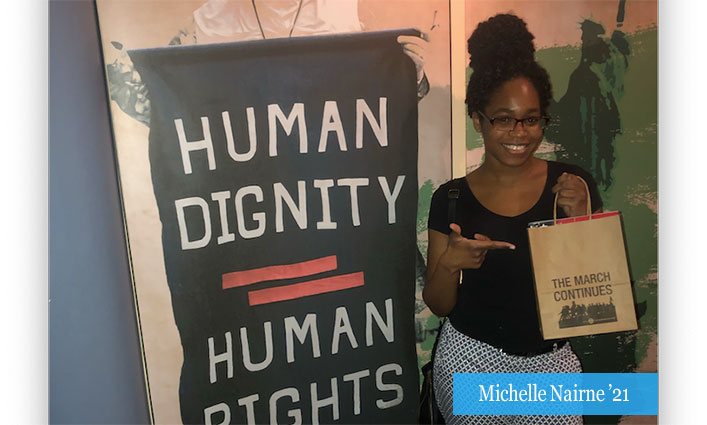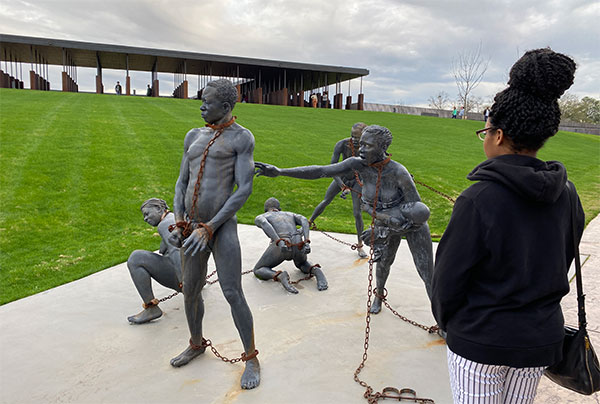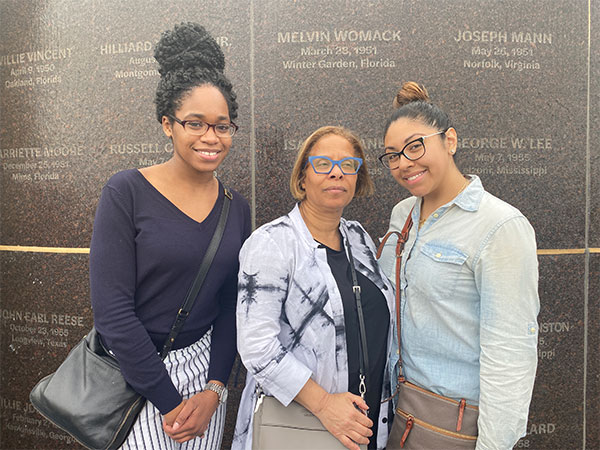
Our country has a painful history of racial injustice. It’s a history we need to reckon with, and a cruel ideology that we can no longer deny still exists today. Our communities of color regularly navigate hostile spaces, face overt acts of racism, and experience racial microaggressions that attack their dignity and humanity. But silence is complicity. That’s why John Jay students, faculty, staff, and alumni are finding ways to protest anti-Black behavior and systemic racism. We’re supporting each other, examining our own feelings and actions, and actively fighting unjust treatment throughout our society.
Michelle Nairne ’21, a Law and Society major from Queens, New York, has seen too many acts of violence committed against Black people in her short 19 years of life. As a Black woman, Nairne has learned to process the fear and trauma she’s feeling, while also educating those around her about the Black experience in America. Nairne’s essay examines how she handles that education process, and how she’s learned to appreciate true allies.
“The unity I’ve witnessed around the world has given me a glimmer of hope.” —Michelle Nairne
The word “incessant” is defined as something unpleasant continuing without pause or interruption. That definition feels a lot like the Black experience in America. Even though racial issues are not televised every day, there are many incidents happening every day where Black people are threatened, terrorized, or even killed. Tragedies such as Ahmaud Arbery, Breonna Taylor, and George Floyd remind us of the ever-present racial inequality we’ve been experiencing throughout our country’s history. They serve as constant reminders that when you’re growing up Black in America, you’re regularly exposed to these horrible incidents. It’s personal for me not only because I am a Black woman in America, but because I’ve been to the birthplace of the Civil Rights Movement in Alabama, I’ve watched films on Black struggles and achievements, and I’ve seen my people’s lives being taken away left and right. At times I’ve felt hopeless. I’ve gotten too used to seeing these problems arise, and then slowly watched the activism and fervor for change fade away. I'm tired of not seeing any significant, structural change against systemic racism in our country, despite the clarity of how badly it needs to be done. But the unity I’ve witnessed around the world has given me a glimmer of hope. The conversations I’ve had with my friends has restored my faith that change is possible. They’ve changed me for the better.

“Seeing the pictures of Black men and women being lynched, beaten, and murdered, simply for wanting equality hit me hard and I felt overwhelmed.” —Michelle Nairne
What I Learned in Alabama
Back in January, the Honors Program took a few students down to Alabama to be immersed in the history of the Civil Rights Movement, and to experience what life was like for Black people during that time. I learned new things, and was reminded of things I’ve always known. Seeing the pictures of Black men and women being lynched, beaten, and attacked, simply for wanting equality, hit me hard and I felt overwhelmed. If it weren't for my friends supporting me throughout the trip, I don't know how I could have gotten through the experience. I'll never forget a postcard that I saw at The Legacy Museum. On it was a chilling photo of a Black man being hanged while a mob of white people surrounded him. This public lynching was their entertainment. This was exciting for them. This was, and in many ways still is, life in America.
“Mr. Floyd’s death was a public lynching, just like what I saw on that brutal historical postcard.” —Michelle Nairne
What I Experienced Watching George Floyd’s Death
On Memorial Day, George Floyd was murdered. Mr. Floyd’s death was a public lynching, just like what I saw on that brutal historical postcard. When I saw the horrific video, I froze, and my heart sank. I cried my eyes out most of the night. The incident felt personal in a way I can't describe. The video showed me a coldness in the world, a coldness and disregard for life that felt familiar as a Black person in America. I just kept asking, “Why? Why would he do this? Why is this officer so evil and hateful?” A few days later, the protests started. At first, I thought it was nothing—we’ve seen it all before after the deaths of: Eric Garner, Michael Brown, Sandra Bland, Philando Castile, Atatiana Jefferson, Alton Sterling, Botham Jean, Aiyana Jones, Tamir Rice, Freddie Gray, and Walter Scott. But then I saw a news article that said, “Protests in London, Berlin, Italy.” My eyes practically popped out of my head. I have never in my life seen this much support for Black lives around the world. It was people of all backgrounds supporting and fighting for the rights of Black Americans. All of this prompted me to discuss what was going on with my non-Black friends, and ask them how they felt about it. We discussed the events openly for long periods of time. Some of my closest friends, who are not Black, spoke passionately about the issues and showed a tremendous amount of support for the Black Lives Matter movement. It made me proud that this small group of people, who I talk to almost every day, care as deeply as I do. We all considered anti-Black racism a human rights issue that everyone—not only Black people—should actively fight.

“America has an abundance of work to do. This involves everybody, especially those at the highest levels of our democracy, to change our laws, legislation, and policies.” —Michelle Nairne
What I’ve Discovered Educating My Friends
While talking with my friends about anti-Black issues, I was surprised by the dynamic within our conversations. I wasn’t necessarily the “teacher” per se, but more of a mentor. What I mean by this is that my friends are somewhat educated on Black issues, but wherever I saw that they required more depth, I gave them more information to help them fully understand the Black experience in America. If I could write a manual titled “Talking About Race with Your Friends” my top five tips would be:
1. Hear what they have to say first.
2. As you input your thoughts and facts, see if they accept them and let the conversation flow. If you find that you are arguing with that person, and feel cross-examined about Black human rights issues, consider reevaluating the friendship.
3. Discuss ways you both can actively fight racial inequality. This can be in your school, community, or through online efforts.
“Our aim is clear: End racial inequality and injustice.” —Michelle Nairne
4. Be open to different perspectives. Not everyone has a background where they can relate to this issue, but always try to express its importance.
5. Lastly, sometimes talking at someone doesn't always work. Try showing them an interesting film that conveys the reality of Black history. Then over time ease them into documentaries on Black history.
America has an abundance of work to do. This involves everybody, especially those at the highest levels of our democracy, to change our laws, legislation, and policies. It will take time but there are steps that can be taken immediately to better the lives and communities of Black people in this country. Our aim is clear: End racial inequality and injustice.



